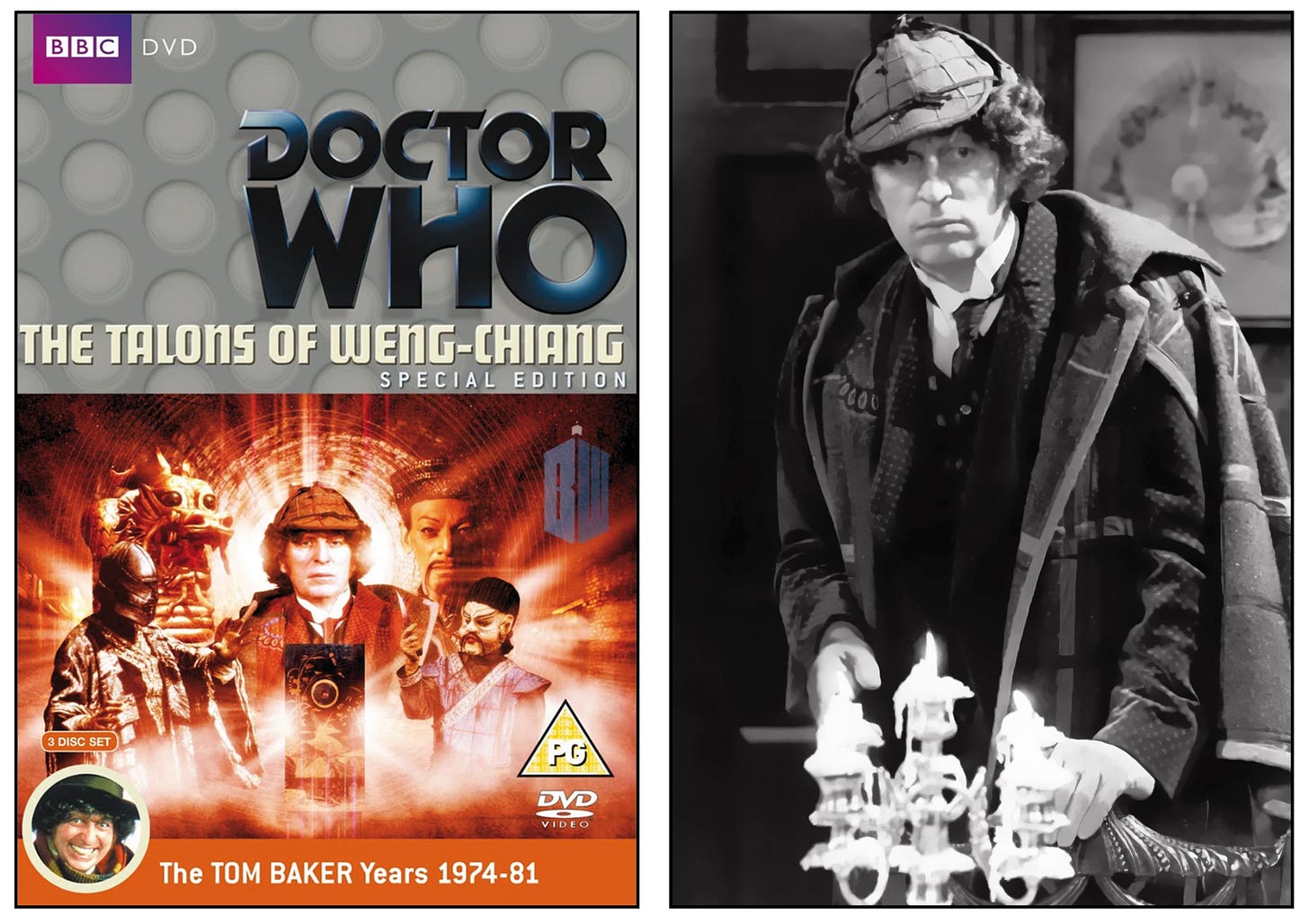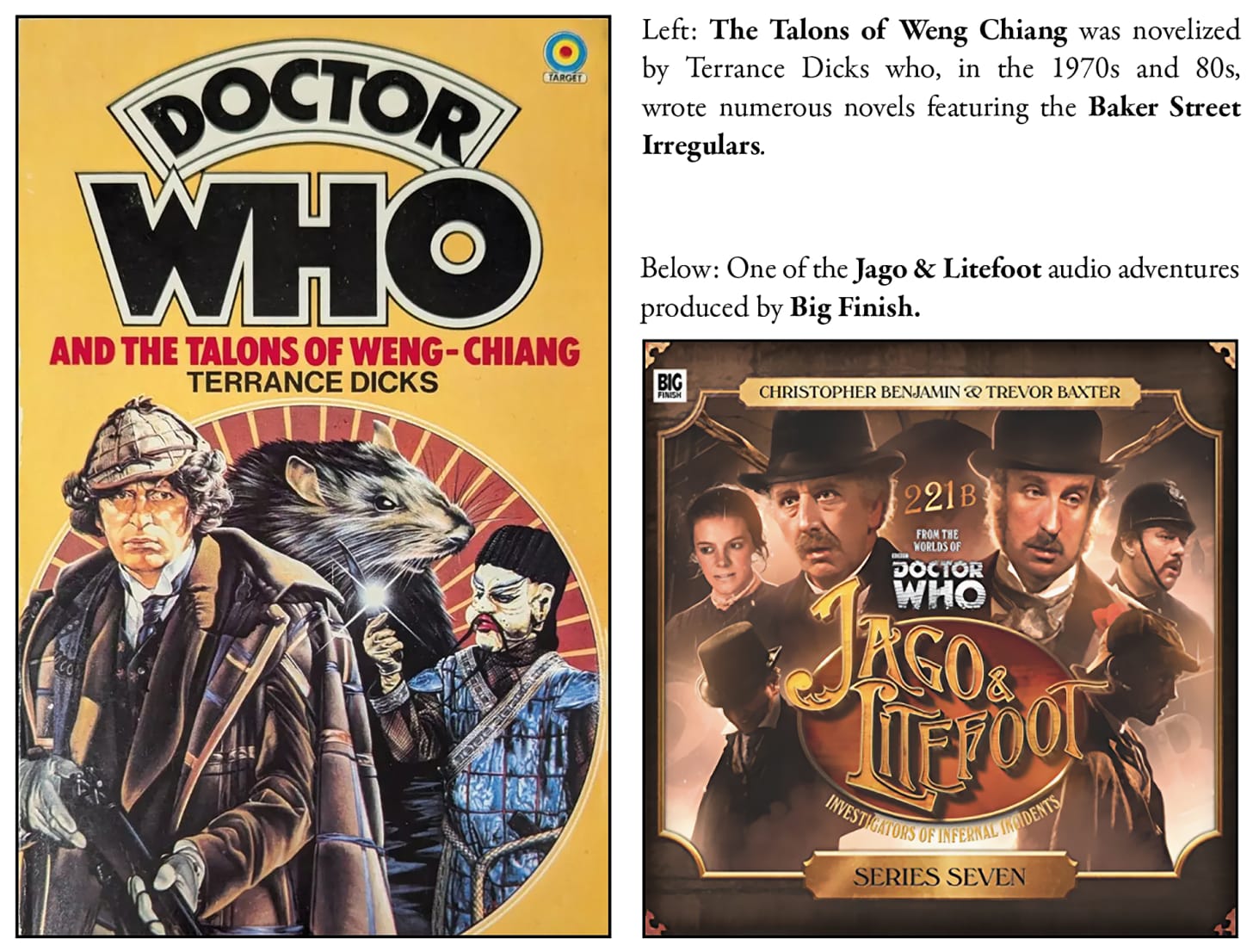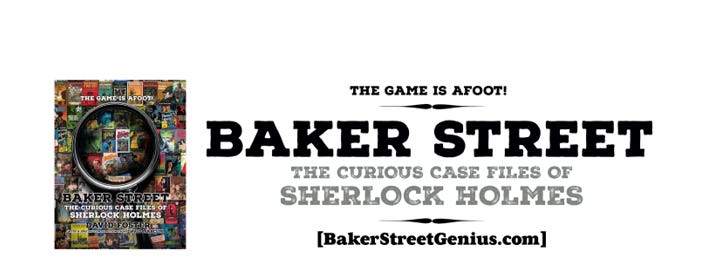Beyond Baker Street: Sherlock Holmes and The Talons of Weng-Chiang
David Foster’s Beyond Baker Street Series
Beyond Baker Street III
Dr. Who and the Deerstalker
The Talons of Weng-Chiang
In 1977, Five years before Tom Baker played Sherlock Holmes in the 1982 BBC adaptation of The Hound of the Baskervilles, he donned a deerstalker and Inverness cape in the decidedly Holmes adjacent Dr. Who adventure, The Talons of Weng Chiang. The story arc for The Talons of Weng Chiang, which was directed by David Maloney, played out over six episodes.
The story is set in Victorian London, in 1889, where eight women have recently gone missing—believed murdered. The tale begins at the Palace Theatre, where Li H’sen Chang (John Bennett), a Chinese magician and mesmer is performing. As part of his act, he uses a ventriloquist’s dummy named Mr. Sin (Deep Roy)—however, as the story plays out, it’s revealed that the dummy is not a dummy at all, but the murderous Peking Homunculus—an automaton with a pig’s brain.
After the performance, Li H’sen Chang is confronted by a hansom-cab driver whose wife, who was last seen at the theatre, has gone missing. Unbeknownst to the driver, Li H’sen Chang is the acolyte of a malevolent Chinese God, named Weng Chiang (Michael Spice) and has been procuring women for his master who requires their life-force. The cab driver threatens to go to the police.
At that time, in an alley not far from the theatre, a blue police call-box appears. From the box steps the Doctor—a Time Lord (Tom Baker), and his assistant, Leela—a warrior woman (Louise Jameson). To fit in with their surroundings, the Doctor is dressed in a deerstalker and cape, while Leela is dressed as a pageboy in pantaloons.
Outside the theatre, as the Doctor and Leela are passing by, the hansom-cab-driver is set upon by Mr. Sin and members of the Tong of the Black Scorpion. The Doctor and Leela intervene but are outnumbered. The driver is stabbed through the heart and the culprits scarper as the police arrive on the scene. The Doctor and Leela are taken to Scotland Yard for questioning.
Later, the hansom-cab-driver’s body is fished out of the Thames. An autopsy reveals not only the stab wound to the heart, but also that his body has been mauled by a giant rodent (one can’t help but think of the “Giant Rat of Sumatra” an untold Sherlock Holmes tale that Watson mentions in The Adventure of the Sussex Vampire). Seeking to discover how the hansom-cab-driver ended up in the Thames, the Doctor and Leela enter the underground sewers, and there they encounter a ferocious giant rat—ten feet long, from nose to tail.
It’s all rather silly, but a great deal of fun—that is if you’re willing to forgive the overt imperialism and racism in the production. John Bennett plays Li H’sen Chang in yellow-face, and beyond the crude racial stereotypes, the dialogue has numerous ethnic slurs.
Two of the Doctor’s allies in this adventure are Henry Gordon Jago (Christopher Benjamin)—proprietor of the Palace Theatre, and Professor George Litefoot (Trevor Baxter)—a police pathologist. Jago and Litefoot proved so popular, they have been revived in a series of audio adventures, published by Big Finish. In the episode, Jago in Love, Jago wilfully suggests he and Litefoot are the inspiration for Sherlock Holmes and Dr. Watson in The Strand Magazine. Incidentally, the name of Litefoot’s housekeeper is Mrs. Hudson.
Beyond Baker Street
I’ve always been fascinated by the shadow cast by Sherlock Holmes—a figure so iconic that his influence seeps into unexpected corners of pop culture. Beyond Baker Street is where I chase those echoes. Whether it’s a villain who once faced Holmes or a story that feels like it should’ve, this series lets me explore the strange tributaries that flow from the great detective’s world.
If you’ve enjoyed this piece, you’ll find even more to explore in my book Baker Street: The Curious Case Files of Sherlock Holmes—a deep dive into 100+ years of Sherlock Holmes in print, film, television, and beyond. From Conan Doyle’s original stories to pastiches, parodies, and pop culture echoes, it’s a must-read for Holmes fans and curious minds alike.
Yours in the Spirit of Adventure
David Foster is an Australian best-selling author who writes under the pen names James Hopwood, A.W. Hart, and Jack Tunney. Under the latter, he has contributed three titles to the popular Fight Card series. His short fiction has been published in over 50 publications worldwide, including by Clan Destine Press, Wolfpack Publishing, and Pro Se Productions, to name but a few. In 2015, he contributed to the multi-award-winning anthology Legends of New Pulp Fiction, published by Airship 27 Publishing.
Foster’s non-fiction work appeared in the award-winning Crime Factory Magazine, as well as contributing numerous articles exploring pulp fiction in popular culture to Girl Gangs, Biker Boys, and Real Cool Cats: Pulp Fiction and Youth Culture, 1950 to 1980 (2017, PM Press) and Sticking It to The Man: Revolution and Counterculture in Pulp and Popular Fiction, 1950 to 1980 (2019, PM Press). He has also contributed articles on the ANZAC war experience to Remembrance (2024, Union Street 21).
Foster lives in the old Pentridge Prison Complex, behind high grey stone walls, in inner-suburban Melbourne, Australia.






Great article... Bonza, mate...